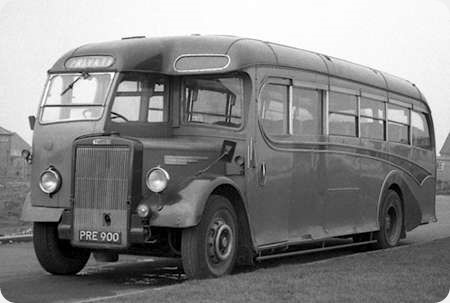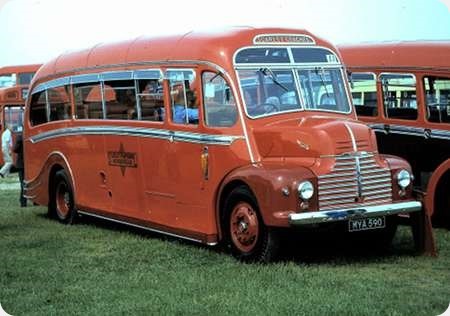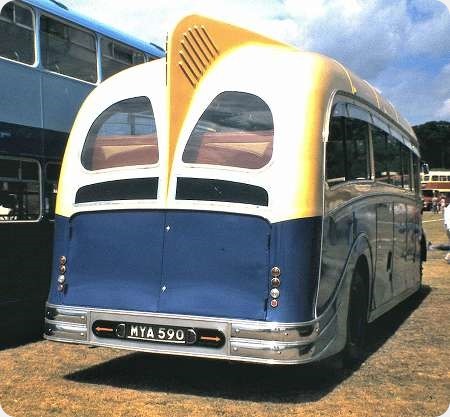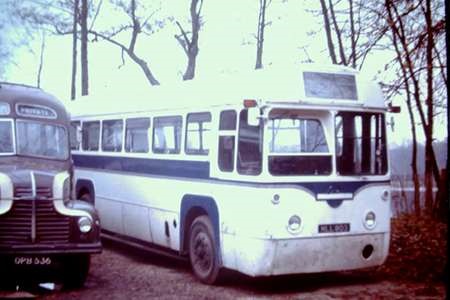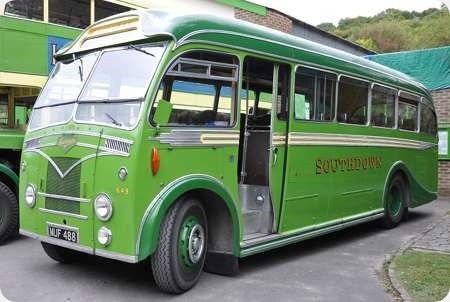Green – Leyland Tiger – PRE 900
Green (Brierley Hill)
1948
Leyland Tiger PS1/1
Burlingham C33F
Seen in the summer of 1961 on a rather run down estate beside Mitcham Common is PRE 900, a Leyland Tiger PS1/1 delivered in July 1948 to Green of Brierley Hill, near Dudley, West Midlands. The C33F body is by Burlingham. I do not know its subsequent history and I cannot see any evidence of legal ownership lettering on the nearside of the vehicle. No trading name is carried either, which suggests that by 1961 it had become a contractors machine. No doubt the registration PRE 900 is now a “cherished” number borne by an otherwise undistinguished motor car, the owner of which is completely oblivious to its decidedly more worthy ancestry. Some history of the Green coaching business may be found here:- www.blackcountrybugle.co.uk/63
The following web page gives a broader view of past coach operation in the Black Country:- www.blackcountrybugle.co.uk/
Photograph and Copy contributed by Roger Cox
09/04/17 – 18:00
Didn’t stay long with Green as it passed to Alexandra of Enfield in December 1948.
Keith Clark
10/04/17 – 06:44
Would anyone like to hazard a guess as to what the angled black oblong on the bulkhead and the item leading from it are?
Phil Blinkhorn
10/04/17 – 06:46
Very interesting photograph, although the vehicle is anonymous, it appears to retain a working destination blind, set to PRIVATE. Also, I believe this is the first half cab coach I’ve ever seen with a near side mirror in that position, attached to the front wing. I suppose that’s what you call a wing mirror in every sense of the description!
Chris Barker
10/04/17 – 09:36
Rear view mirror, Phil.
David Oldfield
10/04/17 – 09:37
Thank Chris, a mirror it is!
Phil Blinkhorn
10/04/17 – 09:37
This wing mirror subject has come up before in discussions about the Margo Regal 1. Nearside mirrors weren’t officially required in the early post war period when PRE 900 was built, and this style of half canopy left only the wing as the place to fix one. This mirror does look like a home made effort, but driving without one must have been decidedly nerve wracking.
Roger Cox
11/04/17 – 07:15
LGOC/London Transport, at least up to LT/ST’s had a metal stick with a small knob on the top affixed to the wing for an indication of parking near the kerb These buses and later ones had rear view mirrors on the bodywork on both sides at roughly driver level. These items can been seen on my photo of the Tilling ST here: www.old-bus-photos.co.uk/
Chris Hebbron
11/04/17 – 07:16
Others fitted nearside mirrors as shown here: www.flickr.com/photos/
Stephen Bloomfield
11/04/17 – 17:38
Nearside mirrors on canopied vehicles work well and give adequate but not great nearside visibility.
I have a number of non canopied single deckers and nearside mirror positioning is standard ie nearside front bulkhead but the angle of the mirror and size becomes really important in making them of any use.
I find myself when driving continually ducking and diving to get max visibility especially for vehicles/cyclists coming up the nearside. A move to convex or larger mirrors only partially solves the problem as this then gives rise to proximity issues.
I had never seen a mirror positioned like on PRE but it does make some sense other than aesthetics
Roger Burdett
12/04/17 – 07:26
I could never understand why London Transport, very advanced in its specifications for "own design" post war fleet, insisted on fitting a minuscule circular mirror for the driver’s nearside visibility. Only the RF class, as I recall, had decently sized rectangular mirrors on both sides of the vehicle. Even the private hire RFWs had the little circular things.
Roger Cox
Quick links to the - Comments Page - Contact Page - Home Page
